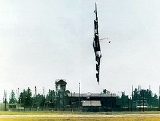
1994 Fairchild Air Force Base B-52 crash
Encyclopedia
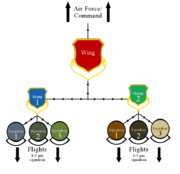
Fairchild Air Force Base
Fairchild Air Force Base is a United States Air Force base located approximately southwest of Spokane, Washington.The host unit at Fairchild is the 92d Air Refueling Wing assigned to the Air Mobility Command's 15th Expeditionary Mobility Task Force...
, Washington, United States
United States
The United States of America is a federal constitutional republic comprising fifty states and a federal district...
on June 24, 1994 when the pilot of a Boeing B-52 Stratofortress, "Bud" Holland, flew the aircraft beyond its operational limits and lost control. The aircraft stalled
Stall (flight)
In fluid dynamics, a stall is a reduction in the lift coefficient generated by a foil as angle of attack increases. This occurs when the critical angle of attack of the foil is exceeded...
, fell to the ground and exploded, killing Holland and the other three United States Air Force (USAF)
United States Air Force
The United States Air Force is the aerial warfare service branch of the United States Armed Forces and one of the American uniformed services. Initially part of the United States Army, the USAF was formed as a separate branch of the military on September 18, 1947 under the National Security Act of...
crew members on board. The crash was captured on film and was shown repeatedly on news broadcasts throughout the world.
The subsequent investigation concluded that the chain of events leading to the crash was primarily attributable to three factors: Holland's personality and behavior, USAF leaders' delayed reactions to earlier incidents involving Holland, and the sequence of events during the aircraft's final flight. The crash is now used in military and civilian aviation environments as a case study
Case study
A case study is an intensive analysis of an individual unit stressing developmental factors in relation to context. The case study is common in social sciences and life sciences. Case studies may be descriptive or explanatory. The latter type is used to explore causation in order to find...
in teaching crew resource management
Crew Resource Management
Crew resource management or Cockpit resource management is a procedure and training system in systems where human error can have devastating effects. Used primarily for improving air safety, CRM focuses on interpersonal communication, leadership, and decision making in the cockpit...
. It is also often used by the US armed forces during aviation safety training as an example of the importance of compliance with safety regulations and correcting the behavior of anyone who violates safety procedures.
Crash
At 07:30 local time (Pacific Time ZonePacific Time Zone
The Pacific Time Zone observes standard time by subtracting eight hours from Coordinated Universal Time . The clock time in this zone is based on the mean solar time of the 120th meridian west of the Greenwich Observatory. During daylight saving time, its time offset is UTC-7.In the United States...
) on June 24, 1994, a USAF B-52H bomber crew stationed at Fairchild Air Force Base prepared to practice an aircraft demonstration flight for an airshow. The crew consisted of pilots
Aviator
An aviator is a person who flies an aircraft. The first recorded use of the term was in 1887, as a variation of 'aviation', from the Latin avis , coined in 1863 by G. de la Landelle in Aviation Ou Navigation Aérienne...
Lt Col
Lieutenant Colonel (United States)
In the United States Army, United States Air Force, and United States Marine Corps, a lieutenant colonel is a field grade military officer rank just above the rank of major and just below the rank of colonel. It is equivalent to the naval rank of commander in the other uniformed services.The pay...
Arthur "Bud" Holland (46 years old), Lt Col Mark McGeehan (38), and Col
Colonel (United States)
In the United States Army, Air Force, and Marine Corps, colonel is a senior field grade military officer rank just above the rank of lieutenant colonel and just below the rank of brigadier general...
Robert Wolff (46), and weapon systems officer
Weapon systems officer
A Weapon Systems Officer is an air Flight Officer directly involved in all air operations and weapon systems of the fighter in the United States Navy. A Weapon Systems Officer ("WSO", pronounced "wizzo") is an air Flight Officer directly involved in all air operations and weapon systems of the...
/radar navigator Lt Col Ken Huston (41). Holland was the designated command pilot for the flight, with McGeehan as the copilot and Wolff designated as a safety observer. Holland was the chief of the 92nd Bomb Wing's Standardization and Evaluation branch, McGeehan was the commander of the 325th Bomb Squadron, Wolff was the vice commander of the 92nd Bomb Wing, and Huston was the 325th Bomb Squadron's operations officer.
The mission plan for the flight called for a demanding series of low-altitude passes, 60° banked turns, a steep climb, and a touch-and-go landing on Fairchild's runway 23. The flight was also Wolff's "fini flight"a common tradition in which a retiring USAF aircrew member is met shortly after landing on his or her final flight at the airfield by relatives, friends and coworkers, and doused with water. Thus, Wolff's wife and many of his close friends were at the airfield to watch the flight and participate in the post-flight ceremony. McGeehan's wife and two youngest sons watched the flight from the backyard of McGeehan's living quarters, located nearby.
The B-52 aircraft, callsign Czar 52, took off at 13:58 and completed most of the mission's elements without incident. Upon preparing to execute the touch-and-go on Runway 23 at the end of the practice profile, the aircraft was instructed to go-around
Go-around
A go-around is an aborted landing of an aircraft that is on final approach.- Origin of the term :The term arises from the traditional use of traffic patterns at airfields. A landing aircraft will first join the circuit pattern and prepare for landing in an orderly fashion...
because a KC-135 aircraft had just landed and was on the runway. Maintaining an altitude of about 250 feet (75 m) above ground level
Above ground level
In aviation and atmospheric sciences, an altitude is said to be above ground level when it is measured with respect to the underlying ground surface. This is as opposed to above mean sea level , or in broadcast engineering, height above average terrain...
(AGL), Holland radioed the control tower
Control tower
A control tower, or more specifically an Air Traffic Control Tower , is the name of the airport building from which the air traffic control unit controls the movement of aircraft on and around the airport. Control towers are also used to control the traffic for other forms of transportation such...
and asked for permission to execute a 360° left turn, which was immediately granted by the tower controller.
The B-52 then began the 360° left turn around the tower starting from about the midfield point of the runway. Located just behind the tower was an area of restricted airspace, reportedly because of a nuclear weapon
Nuclear weapon
A nuclear weapon is an explosive device that derives its destructive force from nuclear reactions, either fission or a combination of fission and fusion. Both reactions release vast quantities of energy from relatively small amounts of matter. The first fission bomb test released the same amount...
s storage facility. To avoid flying through the restricted airspace, Holland apparently flew the aircraft in an extremely tight, steeply banked turn while maintaining the low, 250 foot (75 m) AGL altitude. Approximately three quarters of the way around the turn, at 14:16, the aircraft banked past 90°, descended rapidly, tripped power lines, and hit the ground, exploding and killing the four crew members. McGeehan was seated in an ejection seat, but according to the medical statement, he had only "partially ejected at the time of impact", it does not state whether or not he cleared the aircraft. Huston was also seated in an ejection seat and the medical statement indicated that he had not initiated the ejection sequence. Wolffs' seat was not ejection-capable. No one on the ground was injured.
Investigation
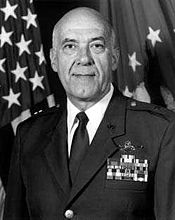
Brigadier General
Brigadier general is a senior rank in the armed forces. It is the lowest ranking general officer in some countries, usually sitting between the ranks of colonel and major general. When appointed to a field command, a brigadier general is typically in command of a brigade consisting of around 4,000...
Orin L. Godsey. The safety investigation board released the report of its investigation into the crash on August 10, 1994. A final evaluation of the safety investigation was released on January 31, 1995. The USAF safety report was distributed only to U.S. Department of Defense
United States Department of Defense
The United States Department of Defense is the U.S...
personnel and not to the general public. An accident investigation board, called an "AFR 110-14 Investigation," released a separate report in 1995. Unlike the USAF safety investigation, the AFR 110-14 report was released to the general public.
The AFR 110-14 investigation identified several factors which contributed to the crash, including the actual crash sequence, the personality and earlier behavior of Bud Holland, previous supervision and lack of corrective action exercised by USAF officers over Bud Holland, mission planning and execution, and other environmental and human factors.
Crash sequence
The investigation found that as the B-52 entered its final turn sequence around the tower, its indicated airspeedIndicated airspeed
Indicated airspeed is the airspeed read directly from the airspeed indicator on an aircraft, driven by the pitot-static system. IAS is directly related to calibrated airspeed , which is the IAS corrected for instrument and installation errors....
(IAS) was 182 knots (337 km/h, 209 mph). Although Holland applied additional engine power after starting the turn, his input came too late to maintain the aircraft's airspeed
Airspeed
Airspeed is the speed of an aircraft relative to the air. Among the common conventions for qualifying airspeed are: indicated airspeed , calibrated airspeed , true airspeed , equivalent airspeed and density airspeed....
, because its turbine engines take up to 8 seconds to respond to throttle movements. Even though the airspeed indicator was available to all four aircrew members, the aircraft's airspeed was allowed to continue to decrease. Eight seconds before impact, the aircraft's IAS had deteriorated to 145 knots (269 km/h, 167 mph) and the aircraft's bank increased past 60°. At this time Holland or McGeehan applied full right spoiler
Spoiler (aeronautics)
In aeronautics, a spoiler is a device intended to reduce lift in an aircraft. Spoilers are plates on the top surface of a wing which can be extended upward into the airflow and spoil it. By doing so, the spoiler creates a carefully controlled stall over the portion of the wing behind it, greatly...
, right rudder
Rudder
A rudder is a device used to steer a ship, boat, submarine, hovercraft, aircraft or other conveyance that moves through a medium . On an aircraft the rudder is used primarily to counter adverse yaw and p-factor and is not the primary control used to turn the airplane...
, and nose-up elevator
Elevator (aircraft)
Elevators are flight control surfaces, usually at the rear of an aircraft, which control the aircraft's orientation by changing the pitch of the aircraft, and so also the angle of attack of the wing. In simplified terms, they make the aircraft nose-up or nose-down...
, and the aircraft entered a turning flight stall (sometimes called accelerated stall). This phenomenon is a stall
Stall (flight)
In fluid dynamics, a stall is a reduction in the lift coefficient generated by a foil as angle of attack increases. This occurs when the critical angle of attack of the foil is exceeded...
that occurs at a higher airspeed than the design stall speed – which always refers to straight and level flight – because the aircraft is turning. Due to the bank of 60° or more, the stall speed for the aircraft was at that moment 147 knots (272 km/h, 169 mph). Thus, flying at 145 knots (269 km/h, 167 mph) IAS the aircraft stalled without sufficient altitude to recover before striking the ground.
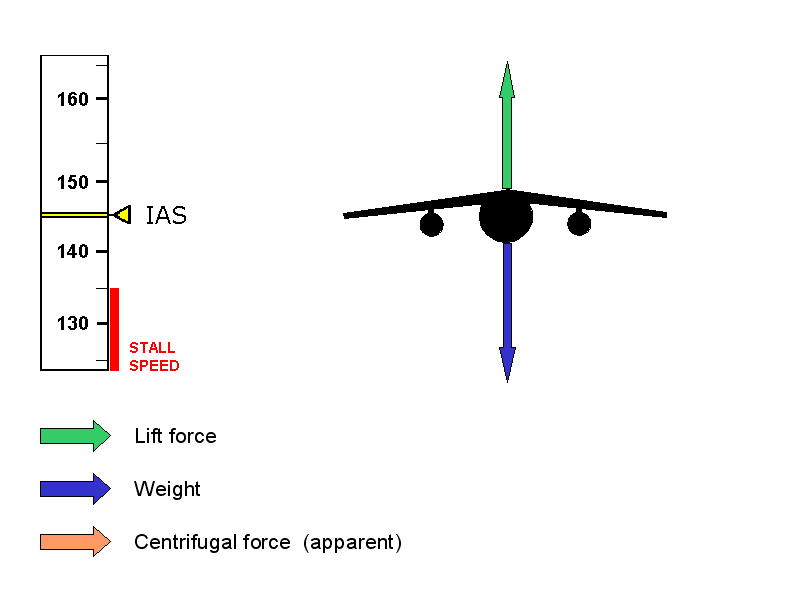
Holland's previous behavior and USAF leaders' reactions
The accident board stated that Bud Holland's personality significantly influenced the crash sequence. USAF personnel testified that Holland had developed a reputation as an aggressive pilot who often broke flight safety and other rules. The rule breaking included flying below minimum clearance altitudes and exceeding bank angle limitations and climb rates.An earlier incident occurred in 1991 when a B-52 piloted by Holland performed a circle above a softball game in which Holland's daughter was participating. Beginning at 2,500 feet (760 m) AGL, Holland's aircraft executed the circle at 65° of bank. Described by one witness as a "death spiral," the nose of the aircraft continued to drop during the maneuver and the bank angle increased to 80°. After losing 1,000 feet (300 m) of altitude, Holland was able to regain control of the aircraft.
During a May 19, 1991, air show at Fairchild, Holland was the command pilot of the B-52 aerial demonstration flight. During the demonstration, Holland's aircraft violated several safety regulations, including exceeding bank and pitch limits, flying directly over the air show spectators, and possibly violating altitude restrictions. The base and wing
Wing (air force unit)
Wing is a term used by different military aviation forces for a unit of command. The terms wing, group or Staffel are used for different-sized units from one country or service to another....
commander, Colonel Arne Weinman, along with his staff, observed the demonstration but apparently took no action.
On July 12, 1991, Holland commanded a B-52 for a "flyover"
Flypast
Flypast is a term used in the United Kingdom, the Commonwealth, and other countries to denote ceremonial or honorific flights by groups of aircraft and, rarely, by a single aircraft...
during a change of command ceremony for the 325th Bomb Squadron at Fairchild. During both the practice and the actual flyover, Holland's aircraft flew at altitudes below 100 feet (30 m)—well below the established minimum altitude—, flew steeply banked turns in excess of 45°, exceeded pitch angle limits, and executed a wingover
Aerobatic maneuver
Aerobatic maneuvers are flight paths putting aircraft in unusual attitudes, in air shows, dog fights or competition aerobatics. Aerobatics can be performed by a single aircraft or in formation with several others...
. The wingover was not specifically prohibited but was not recommended because it could damage the aircraft. After witnessing the flyover, Colonel Weinman and his deputy commander for operations, Colonel Julich, verbally reprimanded Holland but took no formal action.

On April 14 and April 15, 1993, Holland was the mission commander of a two-ship (two B-52 aircraft) training mission to a bombing range near Guam
Guam
Guam is an organized, unincorporated territory of the United States located in the western Pacific Ocean. It is one of five U.S. territories with an established civilian government. Guam is listed as one of 16 Non-Self-Governing Territories by the Special Committee on Decolonization of the United...
in the Pacific Ocean
Pacific Ocean
The Pacific Ocean is the largest of the Earth's oceanic divisions. It extends from the Arctic in the north to the Southern Ocean in the south, bounded by Asia and Australia in the west, and the Americas in the east.At 165.2 million square kilometres in area, this largest division of the World...
. During the mission Holland flew his aircraft closer to the other aircraft than regulations allowed. Holland also asked his navigator to videotape the bombs falling from the aircraft from inside the aircraft's bomb bay
Bomb bay
The bomb bay or weapons bay on some military aircraft is a compartment to carry bombs, usually in the aircraft's fuselage, with "bomb bay doors" which open at the bottom. The bomb bay doors are opened and the bombs are dropped when over the target or at a specified launching point.Large-sized...
, also against regulations. Holland's navigator later brought the video to the attention of three Fairchild USAF leaders. The first, Lieutenant Colonel Bullock, the current 325th Bomb Squadron commander, did not do anything about it and may have even tried to use the videotape for blackmail
Blackmail
In common usage, blackmail is a crime involving threats to reveal substantially true or false information about a person to the public, a family member, or associates unless a demand is met. It may be defined as coercion involving threats of physical harm, threat of criminal prosecution, or threats...
to coerce the navigator into accepting a position as mission scheduler for the wing. The second, the deputy operations group commander, Lieutenant Colonel Harper, told the crew member to conceal the evidence. The third, the DO, allegedly responded to reports of the video by stating, "Okay, I don't want to know anything about that video -- I don't care."
At the August 8, 1993, Fairchild air show, Holland once again commanded the B-52 demonstration flight. The demonstration profile once again included bank angles greater than 45°, low altitude passes, and another high pitch climbing maneuver, this time in excess of 80° nose high. The climb was so steep that fuel flowed out of the vent holes from the aircraft's wing tanks. The new wing commander, Brigadier General James M. Richards, and the new DO, Colonel William E. Pellerin, both witnessed the demonstration but neither took any action.
On March 10, 1994, Holland commanded a single-aircraft training mission to the Yakima Bombing Range to provide an authorized photographer an opportunity to document the aircraft as it dropped training munitions. The minimum aircraft altitude permitted for that area was 500 feet (150 m) AGL. During the mission, Holland's aircraft was filmed crossing one ridgeline about 30 feet (10 m) above the ground. Fearing for their safety, the photography crew ceased filming and took cover as Holland's aircraft again passed low over the ground, this time estimated as clearing the ridgeline by only three feet (1 m). The co-pilot on Holland's aircraft testified that he grabbed the controls to prevent Holland from flying the aircraft into the ridge while the aircraft's other two aircrew members repeatedly screamed at Holland, "Climb! Climb!" Holland responded by laughing and calling one of the crew members "a pussy".
After that mission, the crew decided that they would never again fly with Holland and reported the incident to the bomb squadron leadership. The squadron commander, Lieutenant Colonel Mark McGeehan, reported the incident to Pellerin and recommended that Holland be removed from flying duty. Pellerin consulted with Holland and gave him a verbal reprimand and warning not to repeat the behavior, but refused to take him off flying duty. Pellerin also did not document the incident or the reprimand or notify his superiors, who remained unaware of the incident. McGeehan then decided that in order to protect his aircrews, he (McGeehan) would be the co-pilot on any future missions in which Holland was the command pilot. Evidence suggests that after this incident "considerable animosity" existed between Holland and McGeehan.
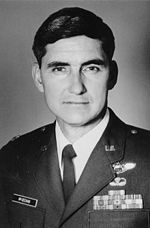
Other factors
The demonstration profile as designed by Holland included a 360° turn around Fairchild's air traffic control tower. Holland had not attempted this maneuver in previous air show demonstrations. During the final flight, Holland performed a series of 60° banked turns and a 68° pitch climb in violation of Brooks' orders. No evidence exists that McGeehan or Wolff attempted to intervene as Holland executed the maneuvers.Pellerin was originally scheduled to fly in this mission, as he had done on the June 17 flight. Pellerin, however, was unavailable for the flight on June 24 and Wolff was selected as the replacement aircrew member. Due to the short notice of his assignment to the mission, Wolff did not participate in the pre-flight briefing and boarded the aircraft after the engines were started. Thus, Wolff was not aware of the planned mission profile and did not have an opportunity to raise any objections before take-off.
All of the aircrew involved in the crash had only limited flying time in the months before the crash. The B-52's aircrew were apparently unaware that the aircraft had stalled until shortly before impact, indicated by a failure to apply standard recovery techniques to the aircraft once it entered the stall. Nevertheless, the investigation reported that even had the proper stall recovery techniques been applied, the aircraft was probably too low to recover before hitting the ground.
Four days before the accident, on June 20, Dean Mellberg, an emotionally disturbed ex-USAF serviceman, entered Fairchild's hospital and shot and killed five people and wounded many more before being killed by an Air Force Security Forces
Air Force Security Forces
United States Air Force Security Forces are the Military Police, Base Security and Air Base Ground Defense forces of the United States Air Force...
member. The crime was a major distraction for personnel stationed at Fairchild for some period of time afterwards.
Conclusions
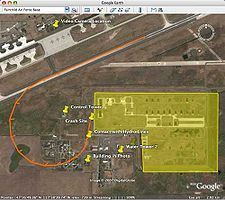
During Holland's last flight, the other environmental factors involved, including the addition of a new maneuver (the 360° turn around the tower), inadequate pre-flight involvement of Colonel Wolff, and the distractions from the base shooting four days prior, combined with Holland's unsafe and risk-taking piloting behavior to produce conditions favorable for the crash to occur. The final factor, according to the USAF investigation report, was the 10 knots (19.6 km/h) wind and its effect on the maneuvers required to achieve the intended flightpath, in relation to the ground.
Aftermath
On May 19, 1995, Pellerin pleaded guilty at a USAF court-martialCourt-martial
A court-martial is a military court. A court-martial is empowered to determine the guilt of members of the armed forces subject to military law, and, if the defendant is found guilty, to decide upon punishment.Most militaries maintain a court-martial system to try cases in which a breach of...
proceeding to two counts of dereliction of duty
Dereliction of duty
Dereliction of duty is a specific offense under United States Code Title 10,892. Article 92 and applies to all branches of the US military. A service member who is derelict has willfully refused to perform his duties or has incapacitated himself in such a way that he cannot perform his duties...
for his actions, or lack thereof, that contributed to the crash. He was sentenced to forfeit $1,500 of salary a month for five months and received a written reprimand. The USAF did not reveal whether any other officer involved in the chain of events leading to the crash received any type of administrative or disciplinary action. Critics of USAF's safety record stated that this crash was an example of a pattern of problems related to enforcement of safety procedures within USAF.
Although the accident investigation found that procedures and policies were supposedly already in place to prevent such a crash from occurring again, the fact that this crash occurred showed that in at least one instance the existing safety policies and their enforcement had been grievously inadequate. To re-emphasize the importance of adherence to existing safety policies and correcting the actions of anyone violating them at any time, the USAF quickly distributed the findings of the accident investigation throughout the service. These measures, however, failed to prevent – sixteen years later – the occurrence in almost identical circumstances of another accident, when a C-17 transport aircraft crashed shortly after taking off from Elmendorf Air Force Base, Alaska, on an aerial display practice flight.
Today, the Fairchild crash is used in both military and civilian aviation environments as a training aid in teaching crew resource management
Crew Resource Management
Crew resource management or Cockpit resource management is a procedure and training system in systems where human error can have devastating effects. Used primarily for improving air safety, CRM focuses on interpersonal communication, leadership, and decision making in the cockpit...
and to show the importance of enforcing safety regulations.
See also
- 2010 Alaska C-17 crash2010 Alaska C-17 crashThe 2010 Alaska C-17 crash occurred on July 28, 2010, when a United States Air Force military transport plane crashed on Elmendorf Air Force Base in Alaska with the loss of all four crew aboard. The aircraft involved was a Boeing C-17 Globemaster III and the crash is believed to be the first fatal...
- List of airshow accidents and incidents
Web
- Biography of the USAF Chief of Safety who led the initial investigation into the mishap.- Biography of the Commander, 92nd Bomb Wing, Fairchild Air Force Base from August 1992 - August 1993- Contains video footage of the crash. – Video of the crashExternal links
- B-52 Fairchild AFB Crash 1994 – full length amateur footage shot from different angle showing the final seven minutes of the flight and subsequent impact.

